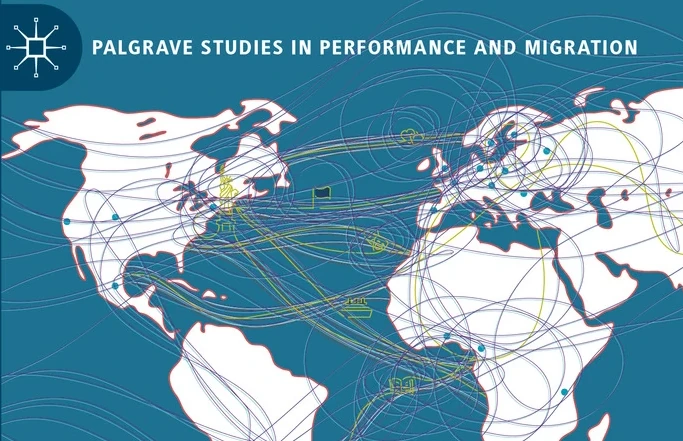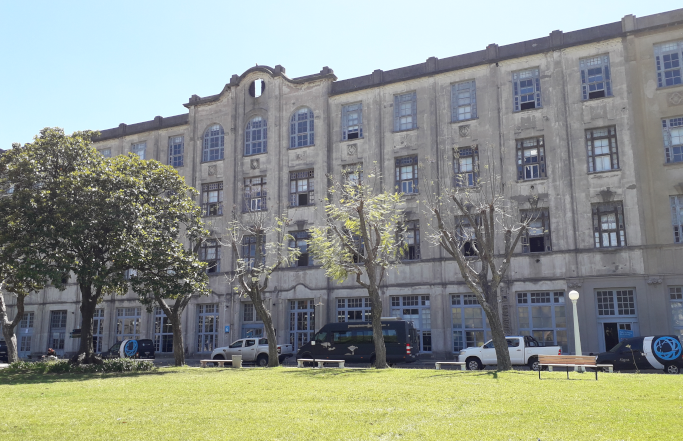Hackathon II
Berenika Szymanski-Düll
A Collaborative Workshop within the LMU-TAU Research Cooperation Programme 2024


A Collaborative Workshop within the LMU-TAU Research Cooperation Programme 2024
From 17 to 19 March 2025, the second Hackathon within the collaboration between T-MIGRANTS and DYBBUK took place at the LMU Institute for Theatre Studies in Munich. Ruthie Abeliovich, Sinai Rusinek, Patrick Aprent, Hanieh Arjomand-Fard, Jorit Hopp, and Berenika Szymanski-Düll met for three intensive days dedicated to integrating data on Jewish theatre migrants into the T-MIGRANTS database and, in doing so, mapping the cross-cultural dynamics of Jewish and non-Jewish theatre migration between 1830 and 1920.
Over the course of three days, we followed a structured workflow, beginning with the transfer and consolidation of existing datasets from the T-MIGRANTS and DYBBUK teams. Through collaborative discussions, we critically examined our data and categorisation strategies, identifying gaps, resolving inconsistencies, and harmonising different data formats. These efforts not only contributed to a more accurate and interconnected understanding of historical migration patterns among theatre professionals but also allowed us to see the first crucial results of our collaborative work while identifying new tasks for further refinement.
All in all, the event was highly productive, and we are excited to continue this work! For further details and insights, stay tuned for our upcoming report on key findings and future research directions.

New Publication
Berenika Szymanski-Düll
European Theatre Migrants in the Age of Empire. Personal Experiences, Transnational Trajectories, and Socio-Political Impacts


We are excited to announce that our book European Theatre Migrants in the Age of Empire is out now!
This edited volume, published by Palgrave Macmillan, explores the crucial yet insufficiently addressed phenomenon of European theatre migration in the long nineteenth century. It argues that theatre migration went far beyond the popular phenomenon of touring, significantly shaping the historical discourse on theatre and mobility. The hidden and multifaceted histories of European theatre migration that this book seeks to explore allow us to rethink national theatre histories as histories of mobility, entanglements, and negotiations. They also allow the reader to challenge and to decenter a European self-understanding of insularity and a European cosmopolitanism ignorant of its imperial and colonial roots.
The book is available both as a hardcover edition and online in an Open Access format.
Many thanks to all contributors!
Research Trip
Vanesa Cotroneo
Following Frank Brown. A Research Trip to English Libraries and Archives


Between the 29th of April and the 9th of May 2023, Vanesa Cotroneo conducted a research trip in England. The main objective was to obtain more information about Frank Brown, an English clown who is one of the protagonists of her PhD project.
Brown, born on 6 September 1858 in Brighton grew up in his father’s circus, the Henry Brown Circus, and subsequently moved to London to pursue his career. During this period, he had the opportunity to work with the Carlo Brothers and to undertake extensive travel, including visits to Russia, the United States and the Anglophone Caribbean. After these tours, Frank Brown settled in Buenos Aires, Argentina, for the rest of his life. From 1884 to 1893, he worked in the circus as an acrobat and clown, but later, after being injured and unable to recover, he concentrated on clowning and became an impresario. As impresario, Frank Brown undertook several transatlantic trips to find and recruit artists from Covent Garden and other important London theatres for performances in his Coliseo Argentino in Buenos Aires.
The artistic biography of Frank Brown in relation to Argentina’s cultural policies constitutes a pivotal element of Vanesa’s doctoral thesis. To gain a deeper understanding of this issue, she conducted research at two significant archives: the British Library of England, located at 96 Euston Road, London, and at The Keep, the main archive in Frank Brown’s birthplace, Brighton. A number of special collections were consulted during the course of this research: The Humanities Room and the Newsroom of British theatre, music hall and variety news at the British Library; the Brighton archive, which contains a number of photographs, documents and census books of interest. A dialogue with librarians and archivists, experts in the field and context, helped to narrow down the material and to identified the relevant material, thus avoiding to get lost in the sheer volume of documents.

Research Trip
Vanesa Cotroneo
Tracing Theatre Migrants from Europe to and in Argentina


My research project focuses on European theatre migrants who came to Argentina between 1850 and 1918 and who made significant theatre contributions to Argentine art in relation to – or in conflict with – the local cultural politics of the time. To this end, I undertook a research trip to Argentina from 12 November to 22 December 2023.
The first research site was the Hotel de Inmigrantes (archive and museum), which was established in 1911 as part of a national policy to welcome and contain the steady immigration flows from Europe to Argentina. The Hotel de Inmigrantes, now the Immigration Museum, directed by Aníbal Jozami, offers scientific information, chronological lines and curated materials originally from the beginning of the 20th century, such as migrants’ suitcases, their letters, and personal objects. The museum also recreates spaces and adds aesthetical exhibition details, as in the case of the migrants’ dormitories, which are surrounded by mirrors that transform the visitor’s perception by multiplying the view of the beds. During my visit, I had the opportunity to speak with Arq. Sergio Sampedro, Chief of the Argentinian National Directorate for Migration, whose department records entrances, trips, and interchanges of migration flows. For example, some of the business trips of theatre migrants are recorded in a digital database that is linked to other websites and information networks, making it possible to follow their trajectories.
The second stop on my research trip was the Archivo General de la Nación (General National Archive), where marine records, manuscripts of immigration laws and captains’ documents are accordingly preserved. In this institution, after thorough research, I was able to locate the itineraries of some important theatre migrants, together with the names of the international shipping companies, complete lists of passengers, from which it was possible to reconstruct entire touring troupes.
My third stop was at the Instituto Nacional de Estudios de Teatro INET (National Institute of Theatre Studies), founded in 1936 and first directed by the European theatre migrant Antonio Cunill Cabanellas. The extensive archive material and the expertise of the director, Prof. Dr. Laura Mogliani, the archivists and the librarians make this place a paradise for theatre scholars, who are welcomed and advised with open arms. In addition to the full days of work at the INET, I had the opportunity to attend to the book launch of Entre la tradición y la modernidad. Historia del Instituto Nacional de Estudios de Teatro (1936-2022), a selection of essays on the history of the National Institute of Theatre Studies of Argentina, by Prof. Dr. Laura Mogliani, published by the Argentine Ministry of Culture. I also visited the Museum’s exhibition “Teatro Criollo entre siglos (1884-1910)” (Creole Theatre between the Centuries (1884-1910)), curated by Dr. Lía Noguera.
The last stop on my research trip to Argentina was the internationally renowned Teatro Colón in Buenos Aires, its archive and library. There, theatre programmes from before and after 1908 – its official founding year – can be consulted. The expertise of the librarians helped me to find the right materials and important books references for further research.
All in all, my research trip to my first home country, following the route of European theatre migrants, reminds me as the granddaughter of European immigrants and Argentine citizens who chose to live in Buenos Aires, I am also part of these migration flows.

Glimps into our work
Jens Jorit Hopp


The development of a viable data model, its implementation as an SQL database, and the creation of a practicable template for data collection were central to our project’s work in recent years. However, it is important to note that a template alone cannot collect data; extensive testing is required for successful data collection. In the late summer of this year, the T-MIGRANTS team gathered in the conference room for a one-day Datathon. At this event, we not only recorded new theatre migrants efficiently and were able to check the viability of our workflow, but also jointly improved our internal documentation to enable new employees to easily start collecting data. Of course, we also made sure we had enough coffee and nourishment to sustain our hard work, as can be seen in the pictures.
Publication
Lisa Skwirblies
Contribution for the online journal Thewis


Lisa Skwirblies contributed an article to the online journal of the German society for Theater studies. The paper discusses the concept ´colonial theatricality´ and queries the extent to which German theatre history is entangled with German colonial history.
https://www.thewis.de/article/view/114
Publication
Lisa Skwirblies
Theaterwissenschaft postkolonial/dekolonial


The edited collection "Theaterwissenschaft postkolonial/dekolonial. Eine
kritische Bestandsaufnahme" by Azadeh Sharifi and Lisa Skwirblies poses
the question what the "decolonisation of the university" could mean for
the field of German theatre studies. The editors invited artists,
activist, and academics to respond to the issue and urgency of
postcolonial and decolonial questions, actions, and aesthetics in
relation to theatre studies and its teaching and research methods. The
contributions are in German and open access available under:
https://www.transcript-verlag.de/978-3-8376-5553-7/theaterwissenschaft-postkolonial/dekolonial/
Publication
Berenika Szymanski-Düll
Contribution for the Journal Forum Modernes Theater


Berenika Szymanski-Düll contributed the essay “
Between Uncertainty, Submission and Hope - Experiences and Reflections on Waiting by Theater Migrants“ for the journal Forum Modernes Theater 2022 (33/1-2). While flight and exile are primarily associated with movement, this article aims to examine their static side, focusing on the element of waiting in the refugee and exile processes of theatre migrants. Examining the memoirs of the playwright, theatre manager and journalist, Heinrich Börnstein (1805-1892), and the documentary stage production What They Want to Hear (2018, Kammerspiele München) by the Argentinian director Lola Arias, it seeks to identify the subjective experiences of waiting of individual theatre makers and asks how they are configured in different settings and over time, in specific geographic and political locations. These subjective experiences of theatre migrants viewed through the analytical lens of waiting provide crucial insights into social organising principles and power hierarchies.

NFDI4Culture
Jorit Jens Hopp
Community exchange NFDI4Culture


The aim of T-MIGRANTS is to open up new ways for evaluating the impact of migration on European and global theatre culture and institutions through the first systematic and in-depth analysis of nineteenth-century European theatre migrants. To open up new ways, however, it is not enough to work on little-explored terrain in order to present original and high-quality research. It is also necessary to question one's own methods and try out new ones. Digital humanities approaches, which are also growing in significance in theatre studies, therefore play an important role in our project. In the past few months, we have built up a database to record the theatre migrants identified within the project and to collect the data gathered with it. The analysis of the data aims to provide information on migration routes, migration centres, migration behaviour and networks of migrants within the theatre business between 1850 and 1918. To further this goal, Berenika Szymanski-Düll and Jorit Hopp joined the
Performance Studies NFDI4C working group in October 2021. This is where productive discussion about the current state of networking, data sharing and publishing within data-based theatre research takes place. In this context, we are looking forward to networking our project with others and exchanging ideas with colleagues about tools and possibilities for sharing and publishing our research data.

Publication
Berenika Szymanski-Düll
Contribution for the European Journal of Theatre and Performance


Berenika Szymanski-Düll contributed an essay for the
European Journal of Theatre and Performance (Issue 3, September 2021). In her article “’To speak Shakespeare in German is almost to speak it in English’: Translocation of Languages on Nineteenth Century Stages”, she pursues the translocation of languages by focusing on two cases: bilingual performances and performances of actors who have performed in non-native languages.
Research
Lisa Skwirblies (PhD)
Theatre-Migration in the Colonial Context – Representations of “race”, imperialism, and theatre migration in the burlesque musical comedy Striese in Kamerun (1887)


Contrary to other colonial empires, the German colonial empire never established a “standing” theatre stage in its colonies. Nevertheless, from the consolidation of the German colonial empire in July 1884 on (and even long before that), theatre played an important and intricate role in the process of empire-building and the establishment of the settler communities imagined as
white in the colonies. In Germany’s African colonies, amateur theatre societies and drama clubs sprung up like mushrooms, initiated by the German colonizers as a means to strengthen the bond among the settlers and to display an alleged German cultural hegemony to the indigenous African communities. In the German metropoles, theatre performances rendered the new and distant colonial empire comprehensible to a domestic audience and fed the fusion of colonial ideology and mass media representation.
It is notable that German colonial plays and performances from the 1880s and 1890s - and thus from the beginning of the colonial project - focused particularly on the question of migration, or, more specifically, on the process of emigration to the colonies.
[1] The one-act burlesque musical comedy
Striese in Kamerun (1887)
[2] by Richard Hirschson und Viktor Hollaender, which I will briefly discuss here, even brings the three phenomena theatre, migration, and colonialism together. It challenges the still common assumption that the German colonial project was a “niche” topic of specialized discourse and testifies instead to the fact that, with the help of the popular theatres, colonial ideology and its representations of ‘race’ reached deep into German imperialist society at the time and were disseminated widely across different classes and milieus. The colonial burlesque is set in the future, in 1896, and the scenery described as having an “African character”. As in many other colonial farces and burlesques of that time, the plot is kept simple and fused with grotesque and often racist humour, bright colours, slapstick and stock-characters. The storyline is constructed around the arrival and integration of new settlers from Germany to one of the African colonies of the German empire: Emanuel Striese, an unsuccessful theatre impresario from a larger German metropole, tired of Europe, emigrates with his unmarried daughters Alma and Hedwig to “Africa”, where he hopes to make a new start professionally. They are eagerly awaited by the European settlers, whose lives in the colony are described as “boring” and “monotonous” and whose hope is that the new theatre with its “ballets, operettas, comedies and melodramas” will bring longed for entertainment. The plot unfolds with Alma’s lover Vittorio, a former tenor at Striese’s theatre in Germany, appearing on the scene. He had been hiding on the same boat as Striese and his daughters and came to “Africa” to ask for Alma’s hand in marriage. As Striese had denied his advances before, Vittorio comes up with a trick to convince his future father-in-law of his worthiness: he dresses up as “an African” tenor, auditions for a role in Striese’s new theatre, and wins over the impresario’s heart. Driven by a colonial idea of discovery and exoticism, and not aware that he has been tricked, Striese is convinced he has found his key to success, a “Black tenor”, who sings even better than the tenors in Germany. In addition to a horrendous fee, Vittorio in blackface also asks for Alma’s hand in marriage. To the distress of Alma, who does not recognize Vittorio in disguise and who does not want to marry “a black man”, Striese agrees to both. Vittorio reveals himself behind the makeup and Alma and he fall into each other’s arms. The play ends with the two young lovers persuading Striese that emigrating to “Africa” had been a foolish idea in the first place and convincing an English man by the name of Mr. Beefsteak, who also resides in the German colony, to invest his entire fortune in Striese’s theatre business. With the new financial boost, the whole theatre family returns to the German metropole.
What then, does the play tell us about the colonial discourse in which (theatre) migration as a topic was embedded in turn-of-the-century Germany? The character of Striese represents what theatre historian Berenika Szymanski-Düll has referred to as a “theatre migrant”
[3]. Out of financial necessity, he leaves his home country and his main place of residence to establish a new theatre business elsewhere. His border-crossing mobility has far-reaching biographical consequences for his family and business, which is one of the parameters that, according to Szymanski-Düll, defines a migratory act as distinct from a journey, or, in the language of the theatre, a tour.
[4] The fact that he maintains ties to his home country, Germany and that he returns to his former place of residence also makes him a “transmigrant”
[5]. A transmigrant is defined as someone, who does not simply migrate from A to B, but whose “public identities are configured in relationship to more than one nation-state”.
[6]
This definition is, however, troubled by the fact that Striese does not migrate to another nation-state, but within the German empire to a so-called German “protectorate”. While emigration from Germany to the US was in full swing at the end of the nineteenth century, emigration to the newly established “protectorates” on the African continent, in New Guinea, China, or Samoa was less popular. Colonial publicists like Friedrich Fabri and Wilhelm Hübbe-Schleiden advertised emigration to the colonies as an important alternative to emigration to the US. Germans emigrating to the colonies would not be “lost” to the German empire, but would stay “German”, culturally and legally, and would, as “cultural pioneers”, help to disseminate German culture worldwide.
[7] What “staying German” meant exactly can be detected from discussions on the citizenship and legal rights of German settlers in the colonies. In their legal status, the German colonies were neither independent states nor parts of the empire. They were subject to the sovereignty of the German empire but not constitutionally incorporated. This meant that in the “protectorates” the citizenship of the German immigrants was largely undefined. In fact, the unclear legal status of German settlers residing in the colonies was partly the reason for a revision of the German citizenship law in 1913. The local populations of the German colonies were
not considered to be members of the empire (
Reichsangehörige). The dual legal system of the colonies separated the people into two different legal categories: “natives” and “non-natives”. “Natives” were defined by colonial law as all members of the “coloured tribes” residing in the colony.
[8] “Non-natives” were referred to by their citizenship (German, British etc.), with certain privileges such as being subject “to the law of the Whites, meaning the German law”.
[9] What becomes clear here is the extent to which “Germanness” was linked to
whiteness. It highlights the intricate relation between migration, race, and citizenship in the German colonial context. Being German in the colonies (and not only there) meant being
white and, more importantly, staying
white. The colonial discourse on migration was dominated by concerns about the settlers’ “racial consciousness”, full with imperial anxieties of
Verkafferung (“going native”) and so-called “miscegenation”. Migrating to the colonies as a
white German citizen was thus deeply informed by questions of race, and an analysis of colonial migration thus requires an expanded definition of concepts such as “theatre migrants” and “transmigrants”, one that includes intersecting questions of race, power, and cultural hegemony.
The play highlights the prominent position of race for colonial migration by making use of a play within a play: Vittorio’s act of “blackfacing”.
[10] While the
whiteness of the European characters goes unnoticed and is thus introduced as the norm in the play, blackness is introduced as a marker of the African “Other”. This is complicated by the fact that the only African character that appears in the play is in fact the
white Vittorio in blackface. More than merely an allegedly innocent symbolic practice, blackfacing was part and parcel of a large array of racialized practice in metropolitan Germany during the colonial era that helped to form a particular image of Africa and Africans and to disseminate racial ideologies and justifications for colonial exploitation and genocide.
[11] The entertainment for the
white metropolitan audience, for whom this play was written, was that they would be able to see through the trick, contrary to Striese. Yet, what they are invited to find behind the make-up is not a
white face but simply a face, a “human” face, their own face unmarked by race. Blackness is performed by Vittorio as a spectacle of Otherness, highlighted as theatrical, as a mask behind which the
white body can hide, from which the
white body can act while remaining invisible, unseen, unmarked. This resonates strongly not only with American minstrelsy traditions but also with a popular trope in German colonial literature and travelogues at the time: the imperialist observer position as invisible and yet all-encompassing. As literature scholar Jonathan Wipplinger has argued, in turn-of-the-century Germany blackface was conceived “as a racial ruse, a joke of identities in flux”.
12] Since blackface appeared mainly on the popular stages (variety and vaudeville theatre) and thus outside of the traditional parameters of bourgeois cultural consumption, it represents an imperial anxiety of intertwining threats for racial and cultural boundaries. In that sense, blackface can be understood as functioning “as a nodal point of societal uncertainty in late nineteenth-century Germany.”
[13] In other words, the choice of theatrical means in the play - the blackfacing - reveals the underlying discursive and performative nexus that influenced and controlled the process of migration to the colonies in the German public sphere: the imperial insecurities of the very notion of what it meant to be German in modernity. It brings to the surface the uncomfortable elements of the radical changes that imperial Germany associated with colonialism and the emergence of mass consumer culture at the end of the nineteenth century and the role that German engagement with race played for the theatrical representation and everyday perception of migration in the colonial and imperial context; elements, that still influence racialized conceptions of migration in Germany today and regularly help to exclude non-white Germans from the narrative of German nationhood and European identity.
[14]
[1] The representation of the colonies and the popular reception of colonial discourse in German theatres developed from the beginning of the colonial movement in the 1880s, through a more diffused colonialism of the 1890s to the high point of colonial propaganda during the German-Herero war between 1904 and 1908.
[2] Hollaender, Viktor; Hirschson, Richard.
Striese in Kamerun. Burleske Operette in einem Akt. Op.25, Libretto, Leipzig (ca. 1887). Digital Version under: https://daten.digitale-sammlungen.de/~db/0006/bsb00063241/images/.
[3] Szymanski-Düll, Berenika. “Vom Reisen, Einreisen und Ausreisen. Zum Mobilitätsverhalten von Theatermigrant*innen im 19. Jahrhundert.” In: Dogramaci, Burcu; Szymanski-Düll, Berenika et.al.
Leave, Left, Left. Migrationsphänomene in den Künsten in aktueller und historischer Perspektive. Neofelis Verlag 2020.
[4] Ibid., p. 65.
[5] Glick Schiller, Nina; Basch, Linda; Blanc-Szanton, Christina. “From Immigrant to Transmigrant: Theorizing Transnational Migration.”
Anthropological Quarterly, Vol. 68, No.1, 1995.
[6] Ibid., p.48.
[7] Another line of argument was that emigration to the colonies would solve the “social question”: the working class would submit to the patriotic task of imperial expansionism and turn their backs on socialist ideas. Mass emigration of the potentially insurgent masses to the colonies would bring new peace and stability to the German empire. But the proposed mass emigration to the colonies never actually materialized. In total, only 24,000 Germans migrated to the German colonies between 1884 and 1913.
[8] Kolonial-Lexikon, 1920, Vol.III, p.312.
[9] Ibid.
[10] As Katrin Sieg has pointed out, the term “blackfacing” is a German linguistic adaption from American minstrelsy culture and denotes images of
white actors in black make-up often linked to stereotypical and racist depictions of a Black person. See Sieg, Katrin. “Race, Guilt, and
Innocence: Facing Blackfacing in Contemporary German Theatre”.
German Studies Review, Vol. 38, No. 1 February 2015, p.117. See also Sharifi, Azadeh. “’Wir wollen ein Zeichen setzen’: Performance and Protest by Minorities in German Theatre.”
Performance Paradigm, Vol. 14, 2018; Mikossé-Aikins, Sandrine. “Not just a Blackened Face.”
Textures: Interweaving Performance Culture, 2013, http://www.textures-platform.com/?p=3169.
[11] See Skwirblies, Lisa. “Colonial Theatricality.” In: Gluhovic, Milija; Jestrovic, Silvija (eds.).
Oxford Handbook of Politics and Performance. OUP 2021.
[12] Wipplinger, Jonathan. “The Racial Ruse: On Blackness and Blackface Comedy in
fin-de-siecle Germany.”
The German Quarterly, Vol. 84, No. 4, Fall 2011, p.458.
[13] Ibid.
[14] See El-Tayeb, Fatima.
Undeutsch. Die Konstruktion des Anderen in der postmigrantischen Gesellschaft. Transcript, 2016.

Publication
Berenika Szymanski-Düll
Contribution to the anthology Methoden der Theaterwissenschaft


Berenika Szymanski-Düll contributed an essay to the anthology Methoden der Theaterwissenschaft (Methods of Theatre Studies) edited by Christopher Balme and Berenika Szymanski Düll, in which she explains the biographical approach within transnational theatre historiography based on examples of her research on theatre migration.
Publication
Berenika Szymanski-Düll
Contribution to the anthology LEAVE, LEFT, LEFT. Migrationsphänomene in den Künsten in aktueller und historischer Perspektive


Berenika Szymanski-Düll contributed an essay to the anthology LEAVE, LEFT, LEFT. Migrationsphänomene in den Künsten in aktueller und historischer Perspektive (Migration Phenomena in the Arts in Current and Historical Perspective) edited by Burcu Dogramaci, Berenika Szymanski-Düll and Wolfgang Rathert. Starting with the distinction between “guest tours” and "migration", her article “Vom Reisen, Einreisen und Ausreisen” describes the mobility behaviour of theatre migrants in the second half of the 19th century.
